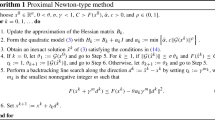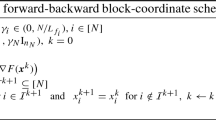Abstract
We propose an inexact linearized proximal algorithm with an adaptive stepsize, together with its globalized version based on the backtracking line-search, to solve a convex composite optimization problem. Under the assumptions of local weak sharp minima of order \(p\ (p\ge 1)\) for the outer convex function and a quasi-regularity condition for the inclusion problem associated to the inner function, we establish superlinear/quadratic convergence results for proposed algorithms. Compared to the linearized proximal algorithms with a constant stepsize proposed in Hu et al. (SIAM J Optim 26(2):1207–1235, 2016), our algorithms own broader applications and higher convergence rates, and the idea of analysis used in the present paper deviates significantly from that of Hu et al. (2016). Numerical applications to the nonnegative inverse eigenvalue problem and the wireless sensor network localization problem indicate that the proposed algorithms are more efficient and robust, and outperform the algorithms in Hu et al. (2016) and some popular algorithms for relevant problems.





Similar content being viewed by others
Notes
This was missed in the statements of [19, Algorithms 10, 17 and 19].
\(\eta ({\bar{x}})\) and \(\beta ({\bar{x}})\) are the local weak sharp minima modulus of order 2 and the quasi-regular modulus around the involved point \({{\bar{x}}}\), respectively.
CVX, designed by Michael Grant and Stephen Boyd, is a MATLAB-based modeling system for convex optimization. Detailed information is available from the website http://cvxr.com/cvx/.
References
Bapat, R.B., Raghavan, T.E.S.: Nonnegative matrices and applications. In: Encyclopedia of Mathematics and Its Applications, vol. 15. Cambridge University Press, Cambridge (1997)
Berman, A., Plemmons, R.J.: Nonnegative matrices in the mathematical sciences. In: Classics in Applied Mathematics, vol. 9. SIAM, Philadelphia (1994)
Bertsekas, D.P.: Nonlinear Programming. Athena Scientific, Cambridge (1999)
Biswas, P., Liang, T.-C., Toh, K.-C., Ye, Y., Wang, T.-C.: Semidefinite programming approaches for sensor network localization with noisy distance measurements. IEEE Trans. Autom. Sci. Eng. 3(4), 360–371 (2006)
Biswas, P., Ye, Y.: Semidefinite programming for ad hoc wireless sensor network localization. In: Proceedings of the 3rd International Symposium on Information Processing in Sensor Networks, pp. 46–54 (2004)
Bonnans, J.F., Ioffe, A.: Second-order sufficiency and quadratic growth for nonisolated minima. Math. Oper. Res. 20, 801–817 (1995)
Burke, J.V.: Descent methods for composite nondifferentiable optimization problems. Math. Program. 33(3), 260–279 (1985)
Burke, J.V.: An exact penalization viewpoint of constrained optimization. SIAM J. Control. Optim. 29, 968–998 (1991)
Burke, J.V., Ferris, M.C.: Weak sharp minima in mathematical programming. SIAM J. Control. Optim. 31(5), 1340–1359 (1993)
Burke, J.V., Ferris, M.C.: A Gauss-Newton method for convex composite optimization. Math. Program. 71, 179–194 (1995)
Burke, J.V., Poliquin, R.A.: Optimality conditions for non-finite valued convex composite functions. Math. Program. 57, 103–120 (1992)
Chu, M.T.: Inverse eigenvalue problems. SIAM Rev. 40, 1–39 (1998)
Chu, M.T., Golub, G.H.: Structured inverse eigenvalue problems. Acta Numer 11, 1–71 (2002)
Drusvyatskiy, D., Lewis, A.S.: Error bounds, quadratic growth, and linear convergence of proximal methods. Math. Oper. Res. 43, 919–948 (2018)
Ferreira, O.P., Gonçalves, M.L.N., Oliveira, P.R.: Convergence of the Gauss-Newton method for convex composite optimization under a majorant condition. SIAM J. Optim. 23, 1757–1783 (2013)
Fletcher, R.: Practical Methods of Optimization. Wiley, New York (1987)
Fuhrmann, P.A., Helmke, U.: Nonnegative matrices and graph theory. In: The Mathematics of Networks of Linear Systems, pp. 411–466. Springer (2015)
Golub, G.H., Van Loan, C.F.: Matrix Computations. John Hopkins University Press, Baltimore (2013)
Hu, Y.H., Li, C., Yang, X.Q.: On convergence rates of linearized proximal algorithms for convex composite optimization with applications. SIAM J. Optim. 26(2), 1207–1235 (2016)
Hu, Y.H., Yang, X.Q., Sim, C.-K.: Inexact subgradient methods for quasi-convex optimization problems. Eur. J. Oper. Res. 240, 315–327 (2015)
Ji, X., Zha, H.Y.: Sensor positioning in wireless ad-hoc sensor networks using multidimensional scaling. In: IEEE INFOCOM, vol. 4, pp. 2652–2661 (2004)
Lewis, A.S., Wright, S.J.: A proximal method for composite minimization. Math. Program. 158, 501–546 (2016)
Li, C., Ng, K.F.: Majorizing functions and convergence of the Gauss-Newton method for convex composite optimization. SIAM J. Optim. 18, 613–642 (2007)
Li, C., Wang, X.H.: On convergence of the Gauss-Newton method for convex composite optimization. Math. Program. 91(2), 349–356 (2002)
Li, G.: Global error bounds for piecewise convex polynomials. Math. Program. 137(1–2), 37–64 (2013)
Luo, Z.Q., Ma, W.-K., So, A.M.-C., Ye, Y., Zhang, S.Z.: Semidefinite relaxation of quadratic optimization problems. IEEE Signal Proc. Mag. 27(3), 20–34 (2010)
Nocedal, J., Wright, S.J.: Numerical Optimization. Springer, New York (2006)
Pang, J.-S.: Error bounds in mathematical programming. Math. Program. 79, 299–332 (1997)
Perfect, H.: Methods of constructing certain stochastic matrices. Duke Math. J. 20, 395–404 (1953)
Perfect, H.: Methods of constructing certain stochastic matrices. ii. Duke Math. J., 22:305–311 (1955)
Qi, L., Sun, J.: A nonsmooth version of Newton’s method. Math. Program. 58(1–3), 353–367 (1993)
Rockafellar, R.T.: First- and second-order epi-differentiability in nonlinear programming. Trans. Am. Math. Soc. 307(1), 75–108 (1988)
Saxe, J.B.: Embeddability of weighted graphs in k-space is strongly NP-hard. In: Proceedings of the 17th Allerton Conference on Communications, Control, and Computing, pp. 480–489 (1979)
Studniarski, M., Ward, D.E.: Weak sharp minima: characterizations and sufficient conditions. SIAM J. Control. Optim. 38(1), 219–236 (1999)
Suleĭmanova, H.R.: Stochastic matrices with real characteristic numbers. Doklady Akad. Nauk SSSR (NS) 66, 343–345 (1949)
Sun, W.Y., Yuan, Y.X.: Optimization Theory and Methods. Springer, New York (2006)
Womersley, R.S.: Local properties of algorithms for minimizing nonsmooth composite functions. Math. Program. 32(1), 69–89 (1985)
Zhao, Z., Bai, Z.J., Jin, X.Q.: A Riemannian inexact Newton-CG method for constructing a nonnegative matrix with prescribed realizable spectrum. Numer. Math. 140, 827–855 (2018)
Zheng, X.Y., Ng, K.F.: Strong KKT conditions and weak sharp solutions in convex-composite optimization. Math. Program. 126, 259–279 (2011)
Zheng, X.Y., Yang, X.Q.: Weak sharp minima for semi-infinite optimization problems with applications. SIAM J. Optim. 18, 573–588 (2007)
Acknowledgements
The authors are grateful to the editor and the anonymous reviewers for their valuable comments and suggestions toward the improvement of this paper. Yaohua Hu’s work was supported in part by the National Natural Science Foundation of China (12222112, 12071306, 11871347, 32170655), Project of Educational Commission of Guangdong Province of China (2021KTSCX103, 2019KZDZX1007), and Natural Science Foundation of Shenzhen (JCYJ20190808173603590). Chong Li’s work was supported in part by the National Natural Science Foundation of China, 12071441 (11971429, 12071441). Jinhua Wang’s work was supported in part by the National Natural Science Foundation of China (Grant 12171131). Xiaoqi Yang’s work was supported in part by the Research Grants Council of Hong Kong (PolyU 15216518).
Author information
Authors and Affiliations
Corresponding author
Ethics declarations
Competing Interests
The authors have not disclosed any competing interests.
Additional information
Publisher's Note
Springer Nature remains neutral with regard to jurisdictional claims in published maps and institutional affiliations.
Appendix
Appendix
Proposition A Let \(c>0\), \(q>1\), and let \(X^*\subseteq \mathbb {R}^{n}\) be closed. Let \(\{x_{k}\}\subseteq \mathbb {R}^{n}\) be a sequence satisfying
If \( \textrm{d}(x_{0},X^{*})< \left( \frac{1}{c}\right) ^\frac{1}{q-1}\), then \(\{x_{k}\}\) converges to a point \(x^*\in X^*\) at a rate of q.
Proof
Assume that \( \textrm{d}(x_{0},X^{*})< \left( \frac{1}{c}\right) ^\frac{1}{q-1}\), and set \(\tau := c \textrm{d}^{q-1}(x_{0},X^{*})\). Then \(\tau <1\), and
because, by the second inequality of (4.4), \(\textrm{d}(x_{k},X^{*})\le c^{\frac{q^k-1}{q-1}} \textrm{d}^{q^k}(x_{0},X^{*})= c^{\frac{q^k-1}{q-1}}\left( \frac{\tau }{c}\right) ^\frac{q^k}{q-1}\le \left( \frac{\tau }{c}\right) ^{\frac{1}{q-1}} \) for each k. In particular, we have that \(\textrm{d}(x_{k},X^{*})\rightarrow 0\).
Now fix \(k\ge 1\). We have from (4.5) that \( \textrm{d}(x_{k},X^{*})\le \textrm{d}(x_{k+1},X^{*})+\Vert x_{k+1}-x_k\Vert \le \tau \textrm{d}(x_{k},X^{*})+\Vert x_{k+1}-x_k\Vert \). It follows that \(\textrm{d}(x_{k},X^{*})\le \frac{1}{1-\tau }\Vert x_{k+1}-x_k\Vert \). Thus, using (4.4), we check that
Set \(c_k:=\frac{ c^2}{(1-\tau )^{q}} \Vert x_{k}-x_{k-1}\Vert ^{q-1}\). Then
Since \(\textrm{d}(x_{k},X^{*})\rightarrow 0\), it follows from (4.4) that \(\Vert x_{k}-x_{k-1}\Vert \rightarrow 0\), and so \(c_k\rightarrow 0\). This, together with (4.6) implies that
\(\{x_k\}\) is a Cauchy sequence and so converges to a point \(x^*\in X^*\) (as \(X^*\) is closed). Furthermore, without loss of generality, we may assume that \(c_{k+1}\le c_k\le \frac{1}{2}\) (see the first inequality in (4.6)). Write \(d_{k}:=x_{k+1}-x_k\) for simplicity. Then (4.6) implies that \( \Vert d_{k+j}\Vert \le c_k^j\Vert d_k\Vert \) for each \(j\ge 1\). Therefore, \( \frac{\sum _{j=1}^{\infty }\Vert d_{k+j}\Vert }{\Vert d_{k}\Vert }\le \frac{c_k}{1-c_k}\rightarrow 0 \), and so \( \lim _{k\rightarrow \infty }\frac{\Vert \sum _{j=0}^{\infty } d_{k+j}\Vert }{\Vert d_{k} \Vert }=1, \) because
Consequently, we conclude that
which means that \(\{x_k\}\) converges to \(x^*\) at a rate of q. \(\square \)
Rights and permissions
Springer Nature or its licensor (e.g. a society or other partner) holds exclusive rights to this article under a publishing agreement with the author(s) or other rightsholder(s); author self-archiving of the accepted manuscript version of this article is solely governed by the terms of such publishing agreement and applicable law.
About this article
Cite this article
Hu, Y., Li, C., Wang, J. et al. Linearized Proximal Algorithms with Adaptive Stepsizes for Convex Composite Optimization with Applications. Appl Math Optim 87, 52 (2023). https://doi.org/10.1007/s00245-022-09957-x
Accepted:
Published:
DOI: https://doi.org/10.1007/s00245-022-09957-x
Keywords
- Convex composite optimization
- Linearized proximal algorithm
- Adaptive stepsize
- Quadratic convergence
- Convex inclusion problem




